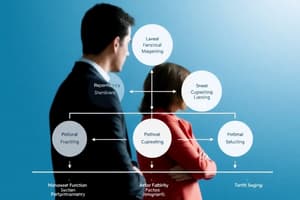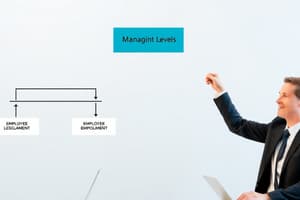Podcast
Questions and Answers
What is the primary focus of management within an organization?
What is the primary focus of management within an organization?
- Integrating organizational resources (correct)
- Achieving individual goals
- Establishing strict hierarchies
- Monitoring employee attendance
Which role is primarily responsible for making short-term operating decisions?
Which role is primarily responsible for making short-term operating decisions?
- Middle managers
- Top managers
- First-Line managers (correct)
- Functional managers
What distinguishes effectiveness from efficiency in an organizational context?
What distinguishes effectiveness from efficiency in an organizational context?
- Efficiency involves measuring resources only, while effectiveness is qualitative
- Efficiency focuses solely on time management
- Effectiveness refers only to resource usage
- Efficiency is about completing tasks while effectiveness is about achieving goals (correct)
Which group of individuals is defined as working autonomously on tasks or in teams without direct managerial oversight?
Which group of individuals is defined as working autonomously on tasks or in teams without direct managerial oversight?
Which type of manager oversees several organizational activities and supervises other managers?
Which type of manager oversees several organizational activities and supervises other managers?
What skill set is crucial for a manager to analyze complex situations and understand the organization as a whole?
What skill set is crucial for a manager to analyze complex situations and understand the organization as a whole?
What is the role of interpersonal skills in managerial effectiveness?
What is the role of interpersonal skills in managerial effectiveness?
What is the primary function of the planning process in management?
What is the primary function of the planning process in management?
What does corporate-level strategy primarily focus on?
What does corporate-level strategy primarily focus on?
What is the main objective of strategy formulation?
What is the main objective of strategy formulation?
Which of the following describes sustainable advantage?
Which of the following describes sustainable advantage?
What is the primary goal of benchmarking?
What is the primary goal of benchmarking?
What does the VRIO framework analyze?
What does the VRIO framework analyze?
Which growth strategy involves entering new lines of business?
Which growth strategy involves entering new lines of business?
What characterizes unrelated diversification?
What characterizes unrelated diversification?
What is the purpose of scenario analysis?
What is the purpose of scenario analysis?
What strategy focuses on offering products of unique and superior value while targeting a narrow market?
What strategy focuses on offering products of unique and superior value while targeting a narrow market?
Which term refers to a plan of action by each functional area to support higher-level strategies?
Which term refers to a plan of action by each functional area to support higher-level strategies?
What is defined as a mechanism for ensuring activities are coordinated and members are motivated to achieve organizational goals?
What is defined as a mechanism for ensuring activities are coordinated and members are motivated to achieve organizational goals?
Which type of culture prioritizes stability and control with an internal focus?
Which type of culture prioritizes stability and control with an internal focus?
Which of the following best describes the concept of 'Execution' in strategizing?
Which of the following best describes the concept of 'Execution' in strategizing?
What does 'Espoused Values' represent in an organization?
What does 'Espoused Values' represent in an organization?
Which strategy is aimed at keeping costs and prices lower than competitors while targeting a narrow market?
Which strategy is aimed at keeping costs and prices lower than competitors while targeting a narrow market?
What aspect of corporate culture determines how a group perceives and reacts to its environment?
What aspect of corporate culture determines how a group perceives and reacts to its environment?
What is a characteristic of objective appraisals?
What is a characteristic of objective appraisals?
Which type of appraisal focuses on employee traits such as initiative and leadership?
Which type of appraisal focuses on employee traits such as initiative and leadership?
What does collective bargaining primarily involve?
What does collective bargaining primarily involve?
Which of the following is a response to workplace discrimination?
Which of the following is a response to workplace discrimination?
What is defined as repeated mistreatment of one or more individuals by others?
What is defined as repeated mistreatment of one or more individuals by others?
What is the focus of the Equal Employment Opportunity Commission (EEOC)?
What is the focus of the Equal Employment Opportunity Commission (EEOC)?
What are Right-To-Work laws designed to prevent?
What are Right-To-Work laws designed to prevent?
What does 'disparate treatment' refer to?
What does 'disparate treatment' refer to?
What is the primary focus of Organizational Design?
What is the primary focus of Organizational Design?
What distinguishes a Boundaryless Organization?
What distinguishes a Boundaryless Organization?
How does Strategic Human Resource Management (SHRM) align with an organization?
How does Strategic Human Resource Management (SHRM) align with an organization?
What is the core purpose of Talent Marketplaces?
What is the core purpose of Talent Marketplaces?
In the context of recruiting, what is the primary difference between internal and external recruiting?
In the context of recruiting, what is the primary difference between internal and external recruiting?
What is the main goal of using Employment Tests in organizations?
What is the main goal of using Employment Tests in organizations?
What is an example of a structured interview?
What is an example of a structured interview?
What are incentives designed to accomplish in an organization?
What are incentives designed to accomplish in an organization?
Flashcards are hidden until you start studying
Study Notes
Organizational Management
- Organizations are groups collaborating for a specific purpose.
- Management involves efficiently and effectively achieving organizational goals through planning, organizing, leading, and controlling resources.
- Efficiency focuses on resource utilization (people, money, materials).
- Effectiveness focuses on achieving results and successfully executing plans.
- Planning involves setting goals and devising achievement strategies.
- Organizing entails arranging tasks, people, and resources.
- Leading motivates and directs individuals towards organizational goals.
- Controlling monitors performance against goals and implements corrective actions.
Management Levels and Roles
- Top managers make long-term decisions and set organizational direction.
- Middle managers implement top management's plans and supervise first-line managers.
- First-line managers handle short-term operating decisions.
- Team leaders facilitate team activities.
- Non-managerial employees perform individual or team tasks.
- Functional managers oversee one organizational activity.
- General managers supervise multiple activities and other managers.
- Interpersonal roles involve internal and external interactions.
- Decisional roles involve problem-solving and opportunity exploitation using information.
Managerial Skills
- Technical skills: Job-specific knowledge.
- Conceptual skills: Analytical thinking and organizational understanding.
- Human skills: Collaboration and teamwork abilities.
- Soft skills: Interpersonal skills crucial for success at all levels.
Strategic Management
- Corporate-level strategy focuses on the entire organization.
- Business-level strategy focuses on individual business units or product lines.
- Functional-level strategy supports higher-level strategies within each functional area.
- Strategy formulation involves selecting and adapting strategies.
- Strategy implementation puts strategic plans into action.
- Sustainable advantage is achieved when competitors cannot replicate value delivery.
Strategic Analysis
- Organizational strengths are special competencies and advantages.
- Organizational weaknesses are drawbacks hindering strategy execution.
- Organizational opportunities are exploitable environmental factors.
- Organizational threats are environmental factors hindering competitive advantage.
- VRIO framework analyzes resources/capabilities based on value, rarity, imitability, and organization.
- Forecasting involves predicting future outcomes.
- Trend analysis projects past events into the future.
- Scenario analysis creates multiple plausible future scenarios.
- Benchmarking compares performance to high-performing organizations.
Grand Strategies
- Growth strategy involves expansion.
- Stability strategy involves minimal change.
- Defensive strategy involves reduced organizational efforts.
- Diversification involves entering new lines of business.
- Related diversification involves acquiring businesses related to existing ones.
- Unrelated diversification involves acquiring businesses in unrelated fields.
Competitive Strategies
- Cost-leadership strategy prioritizes low costs and wide market targeting.
- Differentiation strategy offers superior unique value and targets a wide market.
- Cost-focus strategy prioritizes low costs and targets a narrow market.
- Focused-differentiation strategy offers unique superior value and targets a narrow market.
- Functional strategy supports higher-level strategies within each functional area.
Strategy Execution and Control
- Execution involves aligning strategy with reality, aligning people with goals, and delivering results.
- Performance management assesses and improves employee performance to boost organizational performance.
- Strategic control monitors implementation and takes corrective actions.
Organizational Culture and Structure
- Corporate culture comprises shared assumptions influencing perception and reactions.
- Organizational structure formally coordinates and motivates members through tasks and reporting relationships.
- Human resource practices manage human capital (staffing, appraisal, training, compensation).
- Espoused values are explicitly stated organizational values.
- Enacted values are values actually exhibited.
- Clan culture is internally focused and values flexibility.
- Adhocracy culture is externally focused and values flexibility.
- Market culture is externally focused and values stability and control.
- Hierarchy culture is internally focused and values stability and control.
Organizational Design
- Organization is a coordinated system of activities involving multiple people.
- Division of labor involves assigning discrete parts of a task to different people.
- Hierarchy of authority ensures proper task execution.
- Organizational design structures accountability and responsibility for strategy execution.
- Boundaryless organizations are fluid and adaptive, using technology to link collaborators.
Human Resource Management (HRM)
- HRM involves planning, attracting, developing, and retaining an effective workforce.
- Strategic HRM aligns human capital with strategic objectives.
- High-performance work systems (HPWS) use consistent HR practices to improve employee abilities, motivation, and opportunities.
- Talent marketplaces are digital platforms matching employees with jobs and training.
- Human capital is the economic potential of employee knowledge, experience, and actions.
- Social capital is the potential of strong and cooperative relationships.
Staffing and Compensation
- Recruiting involves locating and attracting qualified applicants.
- Internal recruiting uses existing employees.
- External recruiting seeks applicants from outside.
- Selection screens applicants and chooses the best candidate.
- Unstructured interviews use probing questions.
- Structured interviews use standardized questions and answers.
- Employment tests measure skills, abilities, and traits.
- Base pay is the basic wage or salary.
- Incentives are financial rewards for performance.
- Benefits are additional non-monetary compensations.
Performance Management
- Performance management defines, monitors, measures, evaluates, and provides consequences for performance expectations.
- Performance appraisal assesses performance and provides feedback.
- Objective appraisals are fact-based and numerical.
- Subjective appraisals are based on manager perceptions of traits or behaviors.
- Collective bargaining involves negotiations between management and employees.
- Equal Employment Opportunity Commission (EEOC) enforces anti-discrimination laws.
- Trait appraisals rate subjective attributes.
- Behavioral appraisals measure observable performance aspects.
Workplace Issues
- Workplace discrimination occurs when irrelevant factors influence employment decisions.
- Adverse impact results in unfavorable outcomes for a protected class.
- Disparate treatment involves intentional differential treatment.
- Affirmative action aims for equal opportunity.
- Sexual harassment involves unwanted sexual attention creating a hostile environment.
- Bullying is repeated mistreatment, including physical, psychological, verbal, or nonverbal abuse.
- Labor unions protect and advance members' interests.
- Right-to-work laws prohibit mandatory union membership.
Studying That Suits You
Use AI to generate personalized quizzes and flashcards to suit your learning preferences.




